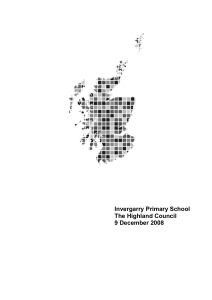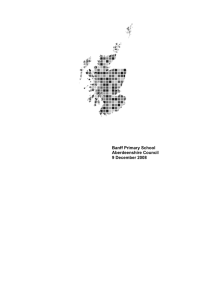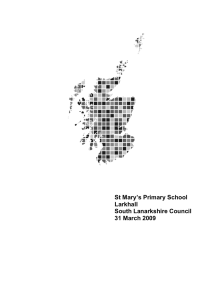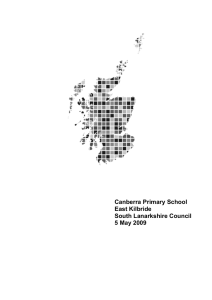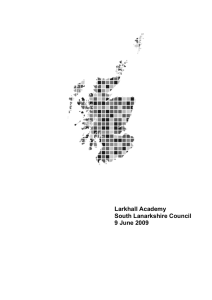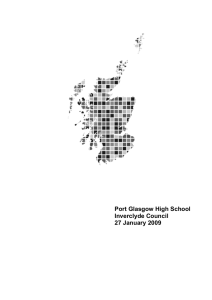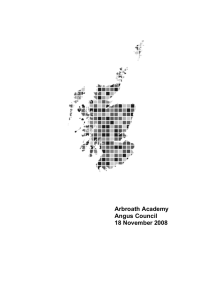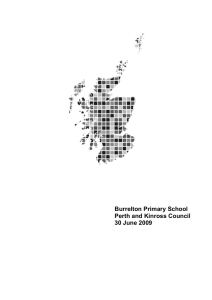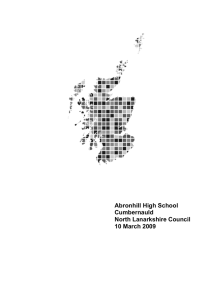Auchmuty High School Glenrothes Fife Council
advertisement
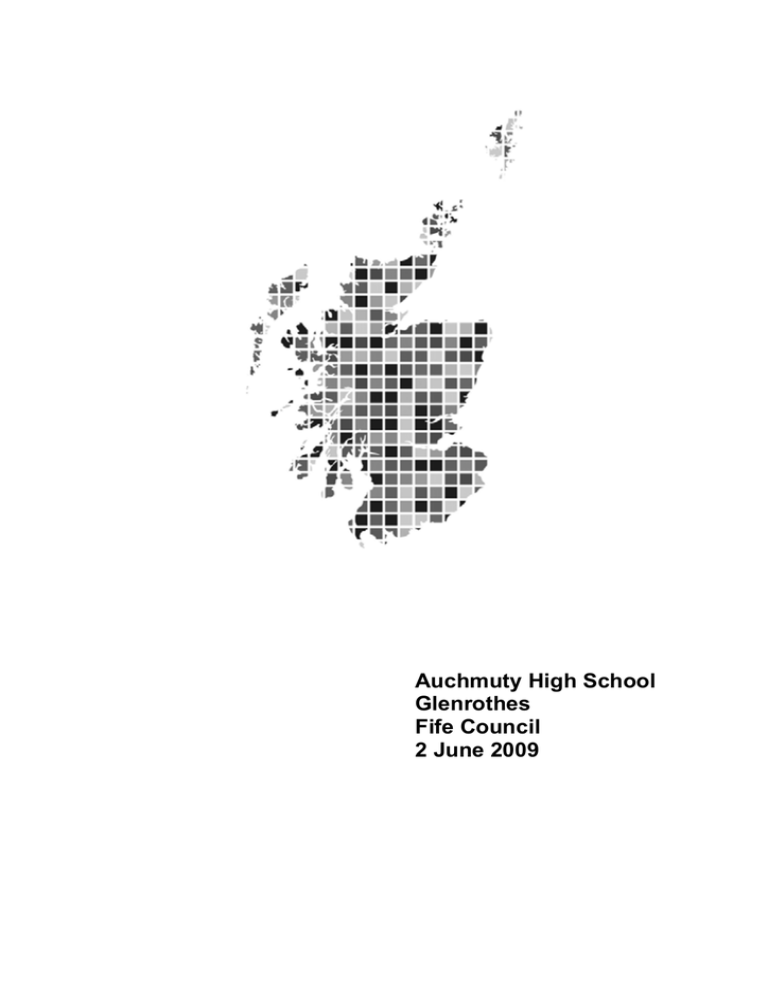
Auchmuty High School Glenrothes Fife Council 2 June 2009 We published a report on Auchmuty High School in June 2007. That report set out key strengths of the school and main points for action. We carried out a follow-through inspection in April 2008 and published a report on this visit in July 2008. This follow-through report is based on an inspection visit which was carried out in March 2009. It tells you about improvements since the original inspection in the quality of education which the school provides. It also comments on how the school is getting on with the main points for action. First we focus on changes in the core work of the school. We explain how the school has got better at helping young people to learn and benefit from being at the school. Next we look at the key processes which enable this to happen, including the involvement of parents1. Our report also describes developments in the ‘ethos’ of the school, by which we mean how well young people are cared for and how much is expected of them in all aspects of school life. Finally we comment on improvements in leadership to help the school achieve its aims. A copy of this report has been placed on the HMIE website www.hmie.gov.uk. Where applicable, you will also find descriptions of good practice in the school and analyses of questionnaire returns. 1 Throughout this report, the term ‘parents’ should be taken to include foster carers, residential care staff and carers who are relatives or friends. Contents 1. The school 2. Particular strengths of the school 3. How well do young people learn and achieve? 4. How well do staff work with others to support young people’s learning? 5. Are staff and young people actively involved in improving their school community? 6. Does the school have high expectations of all young people? 7. Does the school have a clear sense of direction? 8. What happens next? 1. The school Auchmuty High School serves the eastern side of Glenrothes and the surrounding villages. The headteacher at the time of the original inspection resigned in January 2009. At the time of the follow-through inspection one of the depute headteachers was acting headteacher and there were two acting depute headteachers. 1 2. Particular strengths of the school • Staff’s attention to young people’s care and welfare. • The school’s programme of continuing opportunities for young people to achieve in various activities beyond the classroom. 3. How well do young people learn and achieve? Almost all young people enjoy being at school. Overall, there are good relationships between young people and staff. Most young people work cooperatively with their teachers. The behaviour of a small minority interrupts their own learning and that of others. A few young people’s learning is improving because of their more regular attendance and better timekeeping. Young people recognise and comment on improvements in their learning experiences over recent months. There are some good examples of learners being given appropriate tasks and detailed individual feedback about their progress. Overall, there is still too much variability in the quality of young people’s learning. Young people are becoming more confident individuals through their contributions to assemblies, shows and outside events. They are being helped to achieve a range of relevant life skills through taking part in sporting, musical and cultural activities. These activities include school trips and supported study opportunities. By the end of S2, the majority of young people are achieving appropriate levels in reading, writing and mathematics. More young people are achieving national levels in reading. Young people’s performance in national examinations at the end of S5 is improving although girls continue to perform more poorly than boys. The performance of young people at the end of S4 and the end of S6 is continuing to decline in most key measures. 2 At these stages, young people perform less well than, or notably less well than, young people from similar backgrounds in schools with similar characteristics. 4. How well do staff work with others to support young people’s learning? The school has well-developed learning and behavioural support services. Commendably, staff are now identifying a few young people’s needs earlier and appropriate learning and behavioural support programmes are used to meet their needs. The school makes well judged use of outside agencies to provide a wider range of services which are helping to meet young people’s needs. Overall, the school’s planning to meet young people’s additional support needs is not yet sufficiently well coordinated. A minority of staff have yet to improve learning and teaching to more effectively meet the needs of young people with social, emotional and behavioural needs. Staff are very committed to young people’s welfare. The school has improved young people’s preparation for work through a range of initiatives including effective partnerships with further education establishments, Activate and XL programmes. The school needs to continue its work with associated primary schools to ensure better progression in young people’s learning and behaviour as they move from P7 to S1. 5. Are staff and young people actively involved in improving their school community? Staff are now more involved, and young people are beginning to be better involved, in improving their school community. Staff work more as a team by sharing good practice and supporting each other to improve learning and behaviour. Young people collaborate well and enthusiastically in organising events such as school shows and house charity initiatives. Staff show high levels of commitment to the school. They offer a wide range of lunch time and after school activities. There is scope for the school and parents to encourage even greater 3 participation in these activities. Teachers are more committed to and involved in, the process of identifying the school’s strengths and areas for further development. Departmental planning arrangements have improved and the school now has a more comprehensive approach to departmental reviews. Staff now take part in professional review and development and this is linked more closely with programmes for continuing professional development. Young people need to be more involved in evaluating their own learning experiences. 6. Does the school have high expectations of all young people? Staff form good relationships with young people and are supportive of them. Young people feel that staff know them well. They are confident that staff will help them if they have a problem. Young people’s achievements are recognised in newsletters, assemblies and on wall displays. The school recognises that the number of exclusions continues to be high and is currently implementing a revised approach to managing inappropriate behaviour in partnership with parents. The school reward system needs to be reviewed as part of this exercise to ensure that young people do not wait too long for rewards. Young people respond well to a wide range of opportunities in sports and the expressive arts, and have high expectations of personal achievement. Staff need to have higher expectations of the quality of presentation of young people’s work. 7. Does the school have a clear sense of direction? The senior management team (SMT) has worked flexibly to maintain morale. There are some promising examples of leadership being shared across the school. Many staff have also participated in the authority’s ‘Emerging Leader’ programme to help them improve their skills. Staff are now leading working groups. A number of young people serve on the health promotion committee, and others act as buddies or supervise the dining hall and other social areas. There remains a need to further extend leadership opportunities for young 4 people and for staff, particularly at principal teacher level. The school recognises that it needs to raise attainment further. There is a need to ensure that the quality of learning is consistently high. In planning for school improvement, the school should focus more on a reduced number of agreed priorities that are seen through to completion. The SMT need to continue to develop their ability to work as a team. They should also ensure a more consistent focus on learning from all staff across the school. Senior managers should continue to improve their links with subject departments. All staff needed to work together better to improve the management of young people’s behaviour. 8. What happens next? The school has built upon the promising start made at the interim inspection and improved some areas of its work since the original inspection. There remain weaknesses in the quality of attainment at some stages. The improved arrangements now in place for self-evaluation are not yet having a positive effect on the quality of young people’s experiences. We will continue to engage with the school and the education authority in monitoring progress. We will carry out a further follow-through visit to the school after August 2010 and will report to parents on the extent of the improvement that has been achieved. HM Inspector: Donald Macleod 2 June 2009 5 To find out more about inspections or get an electronic copy of this report go to www.hmie.gov.uk. Please contact the Business Management and Communications Team (BMCT) if you wish to enquire about our arrangements for translated or other appropriate versions. If you wish to comment about any of our inspections, contact us at HMIEenquiries@hmie.gsi.gov.uk or alternatively you should write in the first instance to BMCT, HM Inspectorate of Education, Denholm House, Almondvale Business Park, Almondvale Way, Livingston EH54 6GA. Our complaints procedure is available from our website www.hmie.gov.uk or alternatively you can write to our Complaints Manager, at the address above or by telephoning 01506 600259. If you are not satisfied with the action we have taken at the end of our complaints procedure, you can raise your complaint with the Scottish Public Services Ombudsman (SPSO). The SPSO is fully independent and has powers to investigate complaints about Government departments and agencies. You should write to the SPSO, Freepost EH641, Edinburgh EH3 0BR. You can also telephone 0800 377 7330, fax 0800 377 7331 or e-mail: ask@spso.org.uk. More information about the Ombudsman’s office can be obtained from the website at www.spso.org.uk. Crown Copyright 2009 HM Inspectorate of Education
